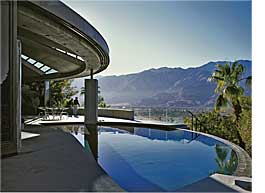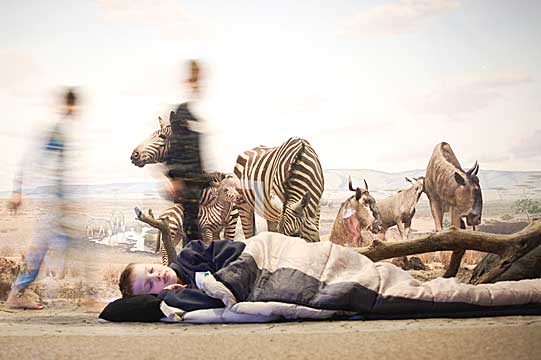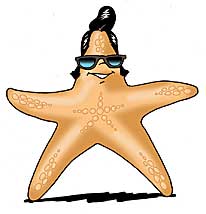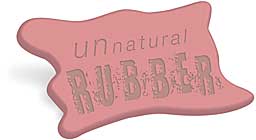| |
 |

Southwestern Exposures
 Before he died this past July at the age of 98, Julius Shulman photographed the creations of Richard Neutra, Albert Frey, John Lautner, and other iconic Modernist architects who redefined the conventional notion of “home” in postwar America. On September 19, his masterworks come to the Museum of Art’s Heinz Architectural Center in Palms Spring Modern: Photographs by Before he died this past July at the age of 98, Julius Shulman photographed the creations of Richard Neutra, Albert Frey, John Lautner, and other iconic Modernist architects who redefined the conventional notion of “home” in postwar America. On September 19, his masterworks come to the Museum of Art’s Heinz Architectural Center in Palms Spring Modern: Photographs by
Julius Shulman.
Julius Shulman, photographer, John Lautner, architect,
Elrod House, 1968, photograph 2007, Palm Springs Art Museum
Nearly 100 of Shulman’s color and black-and-white photographs—many never previously shown—capture the timeless Southern California sophistication of progressive and elegant structures designed by William Cody, William Krisel, and Dan Palmer, to name a few. The exhibition also provides insight into the life and work of each architect, including a 20-minute documentary with commentary by Shulman and architectural historian Alan Hess. Adding a local focus, Palm Springs Modern showcases Richard Neutra’s drawings of the winter home of the late Pittsburgh department store owner Edgar Kaufmann, Sr.
For Art’s Sake
Four score and 19 years ago, a group of forward-thinking regional artists banded together to promote visual arts and home-grown talent within the then Smokey City. While Pittsburgh’s air quality and image have cleaned up considerably in the nearly 10 decades that have passed, the Associated Artists of Pittsburgh remains committed to its original mission, as witnessed in its 99th Annual, on view in the Heinz Galleries through November 8.
 Juried by Doryun Chong, an associate curator at the New York City Museum of Modern Art, the show highlights the creations of regional painters, sculptors, photographers, ceramists, and artists in many other media. Past group members included some of the city’s biggest art stars, including Andy Warhol, Samuel Rosenberg, John Kane, Mary Cassatt, Philip Pearlstein, and Louise Pershing. Among those whose work is featured in this year’s edition are newcomers Lynn Deppen and Nic Vincent along with long-time members Kathleen Zimbicki, Valda Cox, and Kitty Spangler. Juried by Doryun Chong, an associate curator at the New York City Museum of Modern Art, the show highlights the creations of regional painters, sculptors, photographers, ceramists, and artists in many other media. Past group members included some of the city’s biggest art stars, including Andy Warhol, Samuel Rosenberg, John Kane, Mary Cassatt, Philip Pearlstein, and Louise Pershing. Among those whose work is featured in this year’s edition are newcomers Lynn Deppen and Nic Vincent along with long-time members Kathleen Zimbicki, Valda Cox, and Kitty Spangler.
Jack Weiss, Foggy Day at Winters Edge, acrylic on canvas, Steven Mendelson Award, Courtesy of the Artist

Hot Shots

Matterhorn, one of the world’s most famous mountains, in 1960 and 2005.
The sky might not be falling, but the world’s ice packs most certainly are melting. The proof is in the pictures of DOUBLEXPOSURE: Photographing Global Climate Change, a breathtaking and alarming exhibition on view through September 13 in the R.P. Simmons Family Gallery Foyer.
By comparing images taken 70 years apart by legendary mountaineer Bradford Washburn and current Boston Globe writer/photographer David Arnold, DOUBLEXPOSURE reveals
the ravages of global warming on massive glaciers in Alaska and Switzerland. The side-by-side, then-and-now images of the same locations, angles, vantage points, and elevations document the rapid disappearance of these vital, icy landmasses.
Night at the Museum
Dr. Doolittle could chat with cheetahs and curse with kangaroos, but local youngsters can do one better: doze with dinosaurs and wake up next to a grizzly during an action-packed museum all-nighter.

photo: John Altdorfer
Perfect for scout outings, birthday parties, or a fun family adventure, these behind-the-scenes overnight tours give guests the opportunity to explore museum exhibitions—including Dinosaurs in Their Time—up-close and after-hours.
Scheduled during weekends throughout the school year, sleepovers focus on special themes such as solving the mysteries of ancient Egypt, digging for fossils, or joining the CSI unit, the Carnegie Science Investigation team. Whatever the subject, sleepovers fill up fast. For more information, call 412.622.3289.

All Aboard For Fallingwater

Photo courtesy of western pennsylvania conservancy
Every Pittsburgher’s favorite Miniature Railroad and Village® is gearing up for its 88th annual holiday trip around the tracks, with a brand new stop: Frank Lloyd Wright’s Fallingwater.
Each year, the Science Center’s own model builders construct a new addition for the ever-expanding village, which already includes miniature replicas of such venerable Pittsburgh-area landmarks as Forbes Field, Luna Park, and last year’s addition, Isaly’s corner dairy.
Painstakingly re-created to the smallest detail—including the waterfall that inspired the home’s name—the scale-model architectural wonder will add a decidedly Modernistic touch to the exhibit, taking visitors to the futuristic home that Wright designed for Pittsburgh department store magnate Edgar Kaufmann, Sr. Members can hop aboard early with a special members-only sneak peek November 18 from 5 to 8 p.m.
It Will Grow on You
 Starfish do it. As do salamanders and even humans—up to a certain age. That is, they naturally regenerate severed arms, legs, even fingertips. So you might ask yourself, if a starfish can grow a new arm, why can’t I? Starfish do it. As do salamanders and even humans—up to a certain age. That is, they naturally regenerate severed arms, legs, even fingertips. So you might ask yourself, if a starfish can grow a new arm, why can’t I?
That very question is the title of a new interactive exhibit that provides answers about why some creatures possess the ability to regrow missing body parts and others don’t, at least for now. (Children under the age of 11 have been known to regrow fingertips!)
Developed by the Pittsburgh Tissue Engineering Initiative and Carnegie Science Center, the new permanent exhibit, opening October 17, explains the basic science of this cutting-edge field and reveals how local bio-medical researchers are mining the genetic powers of humans to one day sprout full-blown appendages and organs. Early advances show potential for treating combat-related amputations and other traumatic injuries.

 Rubber-made Rubber-made
A world without synthetic rubber could have meant Fords with wooden wheels and chewing gum without the “chew.” Rubber is a vital ingredient in hundreds of everyday objects, from running shoes and basketballs to computer screens and raincoats.
To celebrate the centennial of this indispensable material, Pittsburgh-based LANXESS Corporation, the world’s leading manufacturer of the product, commissioned The Warhol to organize an art competition around the topic. So The Warhol asked 15 contemporary international artists: If given as much synthetic rubber as you want, in any form, and a $75,000 prize to execute your vision, what would you do?
From American movie director John Waters’ proposed five-foot-tall movie theater seat—with a wad of real chewing gum stuck to the bottom of it—to Chicago-based sculptor Tony Tasset’s proposed techno-color rubber ghost, the ideas were ingenious. But there could only be one winner, and a jury of science and contemporary art experts chose a yet to be titled work by artist-duo Hank Willis Thomas and Ryan Alexiev. The 10-foot-tall, dome-shaped sculpture made of tire tread depicts the growth of synthetic rubber production over the past century. It will be on view as part of Unnatural Rubber, opening October 18 at The Warhol, along with the drawings from the 14 other artists. Learn more at www.unnaturalrubber.com.
 Classic Film Trash? Classic Film Trash?
As the old saying goes, one man’s trash is another man’s treasure. But when do old movie posters transform from being insignificant junk to museum-quality art? That’s the question behind SuperTrash: The Dyad and the Duel between Art and Trash, opening October 18.
Curated by filmmaker Jacques Boyreau and Greg Pierce, The Warhol’s assistant curator of film and video, SuperTrash focuses on 150 pieces of movie poster art from the 1940s through the 1980s, along with screenings of popular and obscure films—all illustrating the premise that it’s not always easy to separate the worthless from the worthwhile.
|
|
 Fall 2009
Fall 2009 Before he died this past July at the age of 98, Julius Shulman photographed the creations of Richard Neutra, Albert Frey, John Lautner, and other iconic Modernist architects who redefined the conventional notion of “home” in postwar America. On September 19, his masterworks come to the Museum of Art’s Heinz Architectural Center in Palms Spring Modern: Photographs by
Before he died this past July at the age of 98, Julius Shulman photographed the creations of Richard Neutra, Albert Frey, John Lautner, and other iconic Modernist architects who redefined the conventional notion of “home” in postwar America. On September 19, his masterworks come to the Museum of Art’s Heinz Architectural Center in Palms Spring Modern: Photographs by


 Juried by Doryun Chong, an associate curator at the New York City Museum of Modern Art, the show highlights the creations of regional painters, sculptors, photographers, ceramists, and artists in many other media. Past group members included some of the city’s biggest art stars, including Andy Warhol, Samuel Rosenberg, John Kane, Mary Cassatt, Philip Pearlstein, and Louise Pershing. Among those whose work is featured in this year’s edition are newcomers Lynn Deppen and Nic Vincent along with long-time members Kathleen Zimbicki, Valda Cox, and Kitty Spangler.
Juried by Doryun Chong, an associate curator at the New York City Museum of Modern Art, the show highlights the creations of regional painters, sculptors, photographers, ceramists, and artists in many other media. Past group members included some of the city’s biggest art stars, including Andy Warhol, Samuel Rosenberg, John Kane, Mary Cassatt, Philip Pearlstein, and Louise Pershing. Among those whose work is featured in this year’s edition are newcomers Lynn Deppen and Nic Vincent along with long-time members Kathleen Zimbicki, Valda Cox, and Kitty Spangler. 




 Starfish do it. As do salamanders and even humans—up to a certain age. That is, they naturally regenerate severed arms, legs, even fingertips. So you might ask yourself, if a starfish can grow a new arm, why can’t I?
Starfish do it. As do salamanders and even humans—up to a certain age. That is, they naturally regenerate severed arms, legs, even fingertips. So you might ask yourself, if a starfish can grow a new arm, why can’t I? 
 Rubber-made
Rubber-made Classic Film Trash?
Classic Film Trash?